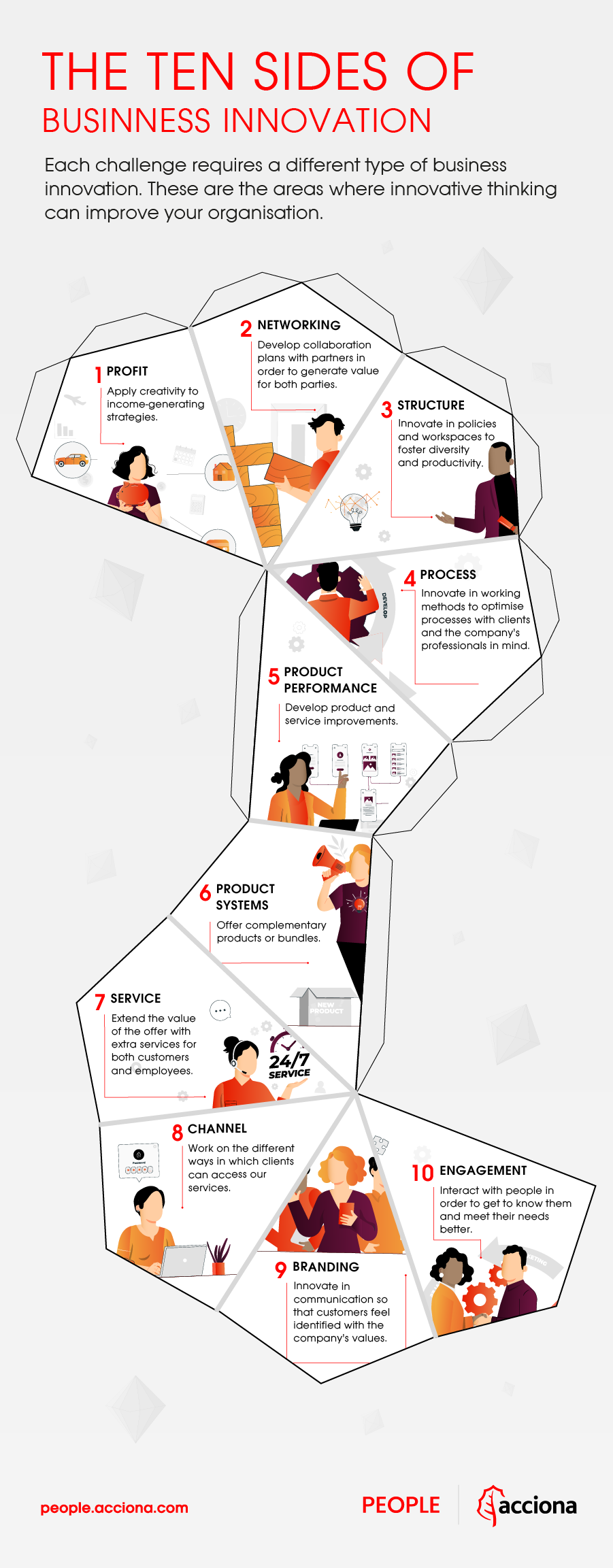When we think of innovation, we tend to believe that the best way to achieve it is to create a better product or service than those already on the market. But this is only one of many. And, in fact, it may not be the best. Do you want to know what kind of approach regarding business innovation suits your organisation? We introduce 10 to you.
What will I read in this article?
Business innovation
Andy Warhol said that, regardless people saying that time changes things, the person who really changes them is oneself. In other words, people have the power to design the future, or at least to influence it and, depending on our decisions, it will be one way or another. Thus, organisations also evolve inspired by the innovations of those who are part of them.
“Organisations always evolve inspired by the innovations of those who are part of them”.
But it seems that many companies fail to implement this concept in both their business and their strategies. The problem, according to writer Greg Satell, is that we fall into the trap of thinking that innovation is a single solution when, in truth, there’s no real path to innovation. Just as we wouldn’t rely on a single marketing tactic or a single source of funding for the life of an organisation, we need to have different types of business innovation designed for specific tasks.
Types of business innovation
According to Brian Quin, author of 10 Types of Innovation, there are three sectors where you can innovate in your company. On the one hand, there’s the configuration of the business model, the most internal part of the company.
On the other hand, the offer, your value proposition, what you promote to consumers. And finally, the experience that your brand creates for your target audiences.
Configurational Innovations

* Profit: basically, it’s related to how we generate revenue. When a company understands innovation through profit, that’s because it understands its customers’ needs very well and transforms the way it earns revenue in order to increase it.
Examples of this are companies that move from a unit sales model to subscription sales. They do not innovate in the product itself, but in how they generate their profit.
* Network: This type of business innovation is about how we can work with others to create shared value. It revolves around bringing together the best of each company so that we can leverage the resources offered by the other party while we are able invest in making our own resources more efficient.
If we want to implement this type of innovation to promote work-life balance for our staff, for example, we can join forces with a childcare company to offer this service to our employees.
* Structure: How can you innovate in your company’s organisation? You can do so by encouraging diversity and inclusion in work teams, a factor that also triggers creativity and other innovations. Or by implementing flexible working models such as ‘hot desking’, which we talked about previously in this article.
* Process: refers to the way companies do things, whether it is how you produce your goods or how you generate your services. One of the latest trends emerging in this field is the ‘paperless’ office, which advocates for a sustainable and 100% digital working model.
Types of supply-side business innovation
* Product performance: this is basically the development of better products or services. It’s the kind of innovation that we all think of first: how can I innovate to make this pen better?
* Product systems: this is about linking different products or offering complementary products.
Types of business innovation based on experience
* Service: How can you extend the value of your offer? With an extra service. Imagine you sell kitchen appliances. You can offer an exclusive after-sales service to your customers on your website with recipes or tips on how to use these tools.
However, this type of business innovation can also be directed towards employees. How can you improve the experience of your workforce? Social benefits are the ideal tools to achieve this. You can make the office a more conciliatory and sustainable place by developing in-company catering, childcare, gym, etc.
* Channel: traditionally, the factory delivered the product to retailers and they delivered it to the end customer. Apple was one of the pioneers in breaking this chain by opening its own shops, unique places where the Apple experience is 100%.
The arrival of the coronavirus crisis and subsequent labour flexibility has led many companies to innovate. Such is the case of BRIO! A company catering brand that now offers employees the possibility of receiving their menu at home instead of at the office.
* Engagement: when a company understands very well the aspirations of its customers or its employees, it decides to innovate by creating experiences between the person and the company to give them additional satisfaction and thus increase their loyalty. This is linked to how people feel and relate to the company. Involving your employees in your philosophy and objectives favours employer branding and increases talent retention.

Sources:
- https://hbr.org/2017/06/the-4-types-of-innovation-and-the-problems-they-solve?language=eshttps://doblin.com/ten-types
- https://people.acciona.com/es/cultura-organizacional/la-clave-del-exito-innovacion-organizacional/


